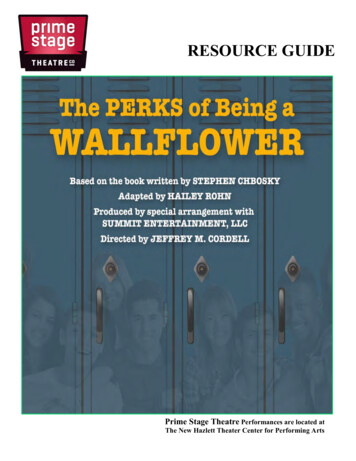
Transcription
RESOURCE GUIDEPrime Stage Theatre Performances are located atThe New Hazlett Theater Center for Performing Arts
Welcome to Prime Stage Theatre’s 2016-2017, 20th Anniversary Season!!Bringing Literature to Life!Dear Educator,We are pleased to bring you the World Premiere play ofThe Perks of Being a Wallflower adapted by Hailey Rohnfrom the book by Stephen Chbosky, our third and finalproduction of the season. The play is produced with specialarrangement with Summit Entertainment, LLC.All literature produced by Prime Stage is always drawnfrom middle and secondary Reading Lists and themes arein the current Pennsylvania curriculum.This Resource Guide is designed to provide historicalbackground and context, classroom activities and curricular content to help you enliven yourstudents’ experience with the literature and the theatre. We encourage you to use the theatricalgames and creative thinking activities, as well as the Theatre Etiquette suggested activities tospark personal connections with the themes and characters in the story of The Perks of Being aWallflower.If you have any questions about the information or activities in the guide, please contact me and Iwill be happy to assist you and I welcome your suggestions and comments!Linda Haston, Education Director & Teaching ArtistPrime Stage Theatrelhaston@primestage.comThe activities in this guide are intended to enliven, clarify and enrich the text as you read,and the experience as you watch the literature.Prime Stage Theatre Resource Guide – Page 2
Our Education Programming is funded in part by the following:Literacy In ACTion ProgramStudent Matinee Field TripsGlobal LearningTheatre Mentor/InternsProfessional DevelopmentEducation DirectorTeen Dating AwarenessPrime Stage Theatre Resource Guide – Page 3
Featured National Standards:English/Language ArtsStandards Developed by International Reading Association and National Council ofTeachers of English1. Students read a wide range of literature from many periods in many genres to build anunderstanding of the many dimensions (e.g., philosophical, ethical, and aesthetic) ofhuman experience.2. Students apply a wide range of strategies to comprehend, interpret, evaluate, andappreciate texts. They draw on their prior experience, their interactions with other readersand writers, their knowledge of word meaning and of other texts, their word identificationstrategies, and their understanding of textual features (e.g., sound-letter correspondence,sentence structure, context and graphics).3. Students use a variety of technological and information resources (e.g., libraries,databases, computer networks, and video) to gather and synthesize information and tocreate and communicate knowledge.4. Students use a variety of technological and information resources (e.g., libraries,databases, computer networks, and video) to gather and synthesize information and tocreate and communicate knowledge.5. Students participate as knowledgeable, reflective, creative, and critical members of avariety of literacy communities.6. Students use spoken, written, and visual language to accomplish their own purposes (e.g.,for learning, enjoyment, persuasion, and the exchange of information).TheatreNA 5-8.3 Designing by developing environments for improvised and scripted scenesStudents analyze improvised and scripted scenes for technical requirements.NA5-8.7 Analyzing, evaluating, and constructing meanings from improvised and scriptedscenes and from theatre, film, television, and electronic media productionsStudents articulate and support the meanings constructed from their and others'dramatic Performances Students use articulated criteria to describe, analyze, andconstructively evaluate the perceived effectiveness of artistic choices found in dramaticperformances.Prime Stage Theatre Resource Guide – Page 4
NA 9-12.2 Acting by developing, communicating, and sustaining characters inimprovisations and informal or formal productionsStudents analyze the physical, emotional, and social dimensions of characters found indramatic texts from various genres and media.NA 9-12.3 Designing and producing by conceptualizing and realizing artisticinterpretations for informal or formal productionsStudents analyze a variety of dramatic texts from cultural and historical perspectives todetermine production requirements.NA9-12.5 Researching by evaluating and synthesizing cultural and historical informationto support artistic choicesStudents identify and research cultural, historical, and symbolic clues in dramatictexts, and evaluate the validity and practicality of the information to assist in makingartistic choices for informal and formal productions.NA9-12.7 Analyzing, critiquing, and constructing meanings from informal and formaltheatre, film, television, and electronic media productionsStudents articulate and justify personal aesthetic criteria for critiquing dramatic texts andevents that compare perceived artistic intent with the final aesthetic achievement.Students analyze and critique the whole and the parts of dramatic performances, takinginto account the context, and constructively suggest alternative artistic choices.Prime Stage Theatre Resource Guide – Page 5
All Prime Stage productions and Resource Guides address the following:Pennsylvania Common Core Standards for Perks:Pennsylvania Academic Standards for Reading, Writing, Listening, SpeakingCC.1.3.9-10.A: Determine a theme or central idea of a text and analyze in detail its developmentover the course of the text, including how it emerges and is shaped and refined by specificdetails; provide an objective summary of the text.CC.1.3.9-10.C: Analyze how complex characters develop over the course of a text, interact withother characters, and advance the plot or develop the theme.CC.1.3.9-10.D: Determine the point of view of the text and analyze the impact the point of viewhas on the meaning of the text.CC.1.3.9-10.E: Analyze how an author’s choices concerning how to structure a text, orderevents within it and manipulate time create an effect.CC.1.3.9-10.F: Analyze how words and phrases shape meaning and tone in texts.CC.1.3.9-10.G: Analyze the representation of a subject or a key scene in two different artisticmediums, including what is emphasized or absent in each treatment.CC.1.3.9-10.H: Analyze how an author draws on and transforms themes, topics, character types,and/or other text elements from source material in a specific work.CC.1.3.9-10.K: Read and comprehend literary fiction on grade level, reading independently andproficiently.CC.1.5.9-10.A: Initiate and participate effectively in a range of collaborative discussions ongrades level topics, texts, and issues, building on others’ ideas and expressing their own clearlyand persuasively.CC.1.5.9-10.G: Demonstrate command of the conventions of standard English when speakingbased on grade 9-10 level and content.CC.1.6.11.A: Listen critically and respond to others in small and large group situations. Respondwith grade level appropriate questions, ideas, information or opinions.CC.1.6.11.C: Demonstrate awareness of audience using appropriate volume and clarity informal speaking presentations.CC.1.6.11.D: Listen to and acknowledge the contributions of other students well introducingideas and opinions to enrich the discussion.Prime Stage Theatre Resource Guide – Page 6
Theatre Etiquette and House RulesGoing to a play is a special experience, one that you will remember for a long time.Everyone in the audience has been looking forward to seeing the performance. The productionteam put in many long hours and hard work to mount this performance. If you keep in mindcommon courtesy for the performers as well as your fellow audience members, everyone’stheatre experience will be terrific.A few reminders for attending the theatre. When you arrive, stay with your group at all times, and wait for the ushers to helpyou find your seat. Gum, food, drinks, or candy, are never allowed in the theatre. Please go to the restroom before seating for performance or at intermission. TURN OFF ALL cell phones, pagers, beepers, alarms, anything that can disturbthe production, actors and the audience during the performance. Lights will dim just before a performance and then go dark. Show yourknowledge by sitting quietly and calmly. Do not talk during the performance. The actors on stage can hear you which iswhy you can hear them so well. Laughter is permissible at appropriate times. No taking of pictures or video recording is allowed. Stay in your seat until the cast has taken their curtain call at the end. Showyour appreciation by clapping. The actors love to hear applause. This shows howmuch you enjoyed the performance!Prime Stage Theatre Resource Guide – Page 7
STEPHEN CHOBSKY – American novelist, screenwriterand film directorStephen Chbosky was born in Pittsburgh, Pennsylvania, on January25, 1970. He grew up in a Catholic family made up of his mother,father, and younger sister. As a teenager, Chbosky was moved byJ.D. Salinger's novel, The Catcher in the Rye. Upon graduation fromUpper St. Clair High School he met Stewart Stern, the screenwriterof Rebel Without a Cause, and the two became close friends. Afterwriting The Perks of Being a Wallflower, Chbosky revealed that thecharacter Bill, a literature teacher, was based on Stern and reflectedthe positive influence of Stern on his own development.Chbosky left Pittsburgh to attend the University of SouthernCalifornia's Film Writing Program, where he began work on his firstfilm, The Four Corners of Nowhere, which premiered at theSundance Film Festival. Following this initial success, Chbosky spent the 1990s writingscreenplays that went unpublished, but in 1994 he began work on the novel he is now mostfamous for - The Perks of Being a Wallflower.In a 2001 interview with Ann Beisch of LA Youth, Chbosky described the initial stages of theproject: "I was writing a very different type of book than Perks, but then I wrote the line, 'I guessthat's just one of the perks of being a wallflower.' And I stopped. I realized that somewhere inthat sentence was the boy I was really trying to find." After five years of research andcomposition, Chbosky published the novel in 1999; the book became a bestseller. Chbosky wenton to tell Beisch that he wrote the book "for very personal reasons," and was happy that peoplehad been able to relate to it in such a positive way.The Perks of Being aWallflower was Chbosky'sfirst novel, as well as his mostsuccessful, but Chbosky'stalents extend beyond his roleas a novelist. In 2005, hewrote the screenplay for thefilm version of the Broadwayhit Rent. In 2012, Chboskywent back into film, servingas the screenwriter anddirector of the movie version of The Perks of Being a Wallflower. In a 2012 interview after thefilm was released, Chbosky revealed that he had always hoped his novel would become a film,and that he was thrilled to be so heavily involved in the production. This time, his film effortswere met with great praise. Currently, Chbosky lives in Los Angeles, California, and continuesto write – most recently the screenplay for Beauty and the Beast.Prime Stage Theatre Resource Guide – Page 8
Q&A WITH PLAYWRIGHT - HAILEY ROHNHailey got her start in theatre with the clubs No Refund Theatre and ThePenn State Thespians, the first of which provided the platform to debut thefirst iteration of this stage adaptation. Perks was also her film debut, whereshe got the opportunity to be a featured extra in the movie. A former residentof Pittsburgh, Hailey now resides in DC where she spends her time working atan urban farm and nursery.What drew you to adapt The Perks of Being a Wallflower for the stage?The Perks of Being a Wallflower is a story that has been near to my heart foryears. From reading it as a freshman, to getting cast as an extra in the movie,the characters that Stephen Chbosky brought to life have been there with me every step of the way.In college at Penn State, I was in a club called No Refund Theatre, and we were VERY low budget & didnot sell tickets to our events, so we had a lot of freedom for creative projects. For my senior show, I knewthat I wanted to direct a show that meant a lot to me. I had already been toying with adapting Perks, butwhen my good friend Ryan (who later became my AD) suggested that he was thinking about it, I knewthat it was something that I had to do.What are some of the unique challenges you've encountered as a writer working on this play?One of the biggest challenges has been getting the script in working order for anyone to read. When I firstadapted it, it was meant for an audience that knew the play and was full of stage directions like CHARLIEsits at his record player- is that something we can get? Will have to ask Ryan) that were specificallywritten for the space and budget that was available to me with NRT. The director Jeff Cordell has beeninstrumental in helping me smooth out those gnarly bits and really ironing out the play into somethingthat all audiences can see and comprehend, regardless of prior knowledge of the work.What's something an audience member should know before they go to see this play?Audiences should know that the things that happen to Sam, Patrick, and Charlie happen to everybody.Everyone goes through hardships but everyone also gets to experience falling in love for the first time.These might all be stories, but they're universal experiences that no one has to go through alone.Educator Info:The Perks of Being a Wallflower is a story that is incredibly dear to my heart. I first read it in the 9thgrade, and the relatability of the characters and their stories captivated me. Again and again, thesecharacters have inspired me during some of my darkest times. From the text itself to the opportunity to bean extra in the movie and write the stage adaptation, Stephen Chbosky and the folks at Prime StageTheatre have given me so many great opportunities.The idea for adapting this script came from my involvement win a very low budget theatre club called NoRefund Theatre. I was looking for a play to direct for my senior show, and had been toying with the ideaof adapting Perks when my close friend (and eventual assistant director), Ryan, told me that hewas thinking about adapting Perks. Somehow, Playbill got wind of the production and wrote an articleabout this being the first stage adaptation (well, first to get the legal rights to do it), which is how PrimeStage Theatre found me.Since, I have been hard at work rewriting the play and making it something that anyone could produce,regardless of age, budget, or professional credibility. Jeff, the director, and everyone at Prime StageTheatre have been instrumental in helping me fine tune this work and transform it into something that canbe enjoyed by all while conveying the incredibly poignant and often overlooked stories that happen toeveryone who is sixteen-turning-seventeen.Prime Stage Theatre Resource Guide – Page 9
Q&A WITH DIRECTOR - JEFFREY M. CORDELLQ: Why is directing Perks so special to you, to others, andto today?Life is at its sweetest complexity when we invite others to share treasuredstories with us. That is why I make, study, and teach theatre. That is why Iloaned my copy of The Perks of Being a Wallflower to others who came backstaggered and wanting to talk. That is why, when my former teacher and friendMelissa Hill Grande first told me about this project in Prime Stage’s 20thanniversary season, my heart leapt: “Yes. Of course. Thank God that ishappening! It makes so much sense.”In all of my experiences with Perks – reading it, discussing it, seeing the film version, working towards thisPrime Stage production – the constant that emerges is how this story feels so real and revelatory. StephenChbosky captures the lightning storm of the awakening self in a paperback bottle. The text is truth conveyedthrough art.The words that run through my mind with Perks are: “Yes. Now I know I am not alone.”Perks is set in the South Hills suburbs of Pittsburgh in from August 1991 through August 1992.In 1992, I started my own 9th grade year at Mt. Lebanon High School. My self-confidence and my activitiesblossomed that year, thanks in large part to older teens who befriended and mentored me. Wow, am I glad forall of those times I decided to engage! I also had the gift of supportive parents and outstanding teachers. Ibuilt a network of summer camp “misfit toys” who, through the exchange of long handwritten letters andhandcrafted mix tapes, helped me feel infinite through high school graduation and beyond.I connect deeply with the Perks story.And things do get better.Take, for example, the wonderful chain of events which led me to direct this adaptation. One link of thatchain is that Prime Stage’s production will happen at the New Hazlett Theater. Thanks to the PittsburghPublic Theater and the “A for the Arts” program back in the early 90s, this is the theatre space whereI allowed myself to get lost in theatre as an imaginative art form and where I fell in love with drama.At the Hazlett, I felt I belonged somewhere special, somewhere smart and exciting. The energy is palpablefor me. In 2001, I received opportunities to act, design, and direct at the Hazlett with new companies usingthe space. To return to Pittsburgh this year with this specific project at the Hazlettis powerful kismet.Through this theatrical production of The Perks of Being a Wallflower, we honor our past stories whileencouraging vital conversations about identity and agency for all of those young people currently discoveringthemselves, surviving and thriving NOW.I hope our show communicates to them: “Yes. We understand. Know that You are not alone.” That is thepower of human experiences becoming the written word becoming the public action of live theatre.Prime Stage Theatre Resource Guide – Page 10
COSTUME DESIGN NOTESPerks of Being a Wallflower is a coming of age book and film beloved by many for its intimatelook at teen psychology and sexuality set against the local backdrop of Pittsburgh.The challenges of costume design in this piece are in recreating a world that specifies the early1990's (in terms of Pittsburgh area fashions) coupled with numerous and varied scene changesthat necessitate wardrobe quick changes for actors playing multiple roles and gender changes. Aswith any Prime Stage production, the design and technical teams work in close collaboration tocreate a world found in the literature we are interpreting. In any modern play, the costumes mustsupport the set design which founds the basis for a specific time and place.In "Perks", the world of teenagers from high school classrooms, to the football field/stadium toprom, driving cars and after hour parties are explored and must be explained through costumesand costume pieces.I look forward to creating a world that is somewhat familiar to both old and young teenagerswho have experienced many of the things that the "Perks" characters-especially Charlie, Sam andPatrick-find for themselves.Kim BrownCostume DesignerPrime Stage production of "The Perks of Being a Wallflower," May, 2017Prime Stage Theatre Resource Guide – Page 11
SCENIC DESIGNSet designer’s rendering full truss arch.While thinking about the scenic design for The Perks of Being a Wallflower, the director andI quickly realized that 20 individual scenes would be nearly impossible to fully realize in thespace of the theatre. Instead, we decided to brainstorm how we could present the spirit of thescript (and novel) with a few simplistic elements and still tell the story efficiently.One main idea that we wanted to feature was the ideaof Charlie’s writings. Throughout the play, he istranscribing his thoughts to an unknown recipient, firstwith paper and pen, and then later with the typewriterthat was gifted to him. This notion of writing issimplistically represented in my design asa large white canvas that sweeps from a verticalhanging position down onto the stage floor which thenbecomes that actors’ playing space. Through lights and projectors, the canvas changes shape asthe actors move in and around the space it provides. Similarly, I also wanted to represent astrong nod to Pittsburgh in the design. To support the hanging canvas, I created a truss-likestructure - a design that you would easily find on any of the city’s multiple bridges. We evenwent as far as researching the shade of yellow that was initially used on the bridges around thecity - Aztec Gold.In keeping the visual elements of the show simple but distinct, we have created an environmentthat aides Charlie in telling his story.JohnMichael BohachScenic DesignerPrime Stage production of "The Perks of Being a Wallflower," May, 2017Prime Stage Theatre Resource Guide – Page 12
THE PERKS OF BEING A WALLFLOWER SUMMARYThe Prime Stage “Perks” CastSam – played by Julia Zoratto, Charlie – played by Peter Joseph Kelly StamerraPatrick – played by Logan ShillerThe Perks of Being a Wallflower is a novel written from the point of view of a high school freshman,Charlie. The novel is structured as a series of letters that Charlie writes to an unnamed friend, and thesedocuments chronicle Charlie's trials, tribulations, and triumphs as he goes through his first year of highschool. He begins writing soon after the suicide of his friend Michael, and he feels very alone in the worldas school starts. Early in the year, Charlie meets an older student named Patrick, and Patrick introducesCharlie to his step-sister, Sam. Even though he is a wallflower who mostly sits back and watches the livesaround him, Charlie tries hard to participate and to be more in control of his world. Assisting Charlie onhis emotional journey is his English teacher, Bill, who pays special attention to Charlie and assigns himextra books to read and papers to write for personal enrichment.Although Charlie chronicles his adventures with his new friends in the letters, his writing also reflects thelarger personal problems that he deals with every day. Charlie constantly worries about other people andtries to determine what is going on beneath the surface of society. As the story continues, Charlie's mentalinstability becomes clearer. He is obsessed with his Aunt Helen, who died on Charlie's birthday whenCharlie was a young child. Charlie feels persistent guilt about this death because Helen died while buyingCharlie a second birthday present. His love for Aunt Helen is unwavering.Charlie meets people who deal with difficult personal issues: cheating, abortion, and drug use.At the end of the novel, Charlie realizes that Aunt Helen had abused him. He begins to have a breakdown,but his friends are there to lend assistance. When Sam leaves for college soon after this revelation,Charlie's downward spiral continues and he is hospitalized in due course. After undergoing several weeksof therapy, he comes to terms with the fact that his Aunt Helen molested him. His immense love for herled him to suppress the memories these events.Charlie closes the novel by announcing that he may no longer need to write his letters. He has started tobelieve that he has agency over his own life and that he does not need to be defined by his past. Charlie'sdevelopment and growth as a character demonstrate the perks, and the drawbacks, of being a wallflower.Prime Stage Theatre Resource Guide – Page 13
Novel vs. Movie–a comparisonIn the BookBill, Charlie's English teacher gives hima B on a paper and then starts to givehim books and gets him to do extrareports.In the MovieMr. Anderson asks the students a few questions on thefirst day, and sees that Charlie writes the correctanswers on his paper, but refuses to answer. Theybecome friends and he gives him books.Charlie's sister is hit by her boyfriendand it is big event.This is downplayed.Charlie has a grandfather who has racist He isn't shown.tendencies.Bob tells Charlie about Brad gettingcaught with Patrick and Brad gettingbeat by his father because of it.Patrick tells Charlie while they're at the golf coursetogether telling stories.Patrick pulls a prank and paints all the tools in his shopclass pink.Prime Stage Theatre Resource Guide – Page 14
In the BookCharlie's parent are not religious.Bill is living with his girlfriend thatCharlie meets at the end.In the MovieThe family is portrayed as being fiercely Catholic.Billy's girlfriend is replaced with his wife who Charlienever meets. The relationship between Bill and Charlieis also not as close.Charlie's sister becomes pregnant and he This doesn't happen.takes her to get an abortion.Charlie's sister becomes pregnant and he This doesn't happen. (Happens in a deleted scene that'stakes her to get an abortion.on the DVD).The story is presented as letters writtenby Charlie.Charlie writes, but the story unfolds in a naturalnarrative.Prime Stage Theatre Resource Guide – Page 15
**ACTIVITY IDEA! **5ADAPT A SCENE FROM “Perks”SCRIPT FORMATTING TIPS:Select a short passage from “Perks” novel, and writeyour own script in the space below. You may want tocontinue a scene featured or choose a different part ofthe book. Once your script is written, assign roles, andtake turns acting out the different versions your class hascreated.CAPITALIZE the name of the CHARACTER who isspeaking.(Put stage directions in parentheses.).This scene is from Chapter , Page(s) .(Add on additional pages as needed.)Prime Stage Theatre Resource Guide – Page 16
**ACTIVITIES**After you finished reading the book and seeing the play, try some of these activities!Make Your Own MixtapeMusic is an important part of the book and movie-make your own mixtape of songs that you findmeaningful. What's your tunnel song? What song reminds you of your friends?Write Your Own "Dear Friend" LetterWrite honestly in a journal, on your computer, or wherever else youfeel comfortable in the same "Dear Friend" letter format Charlie uses.See how writing your thoughts down makes you feel and if it helpsyou understand Charlie's need to write the letters.Prime Stage Theatre Resource Guide – Page 17
Manage Your Stress ActivityMake a chart like the one above to fill out the things that are stressful to you. Ask yourself, "Howwill this matter a year from now?" Consider the situation and if the stress will still affect youlong term-this might give you some perspective on smaller problems or allow you to reach outfor help if the worry is bigger.Take this Quiz!Are you a wallflower or a participant? Follow this link to take a short 57586/are-you-a-wallflower-or-a-participatorCreate a circle of control. Put the circle in a notebook, on your computer, in chalk-whateverworks for you. Inside the inner circle, write what things you can control, such as your reaction toevents. In the outer circle, write what is out of your control, like when someone sayssomething negative about you.This is a good visual for teens who get stressed because of events they cannot control.For more ideas about this activity, check out this blogpost: ol.htmlPrime Stage Theatre Resource Guide – Page 18
Answer this .I feel infinite when:Make your own: I'm driving through tunnels I'm I'm hanging out with my friends I'm I’m writing in my journal/diary I'm I'm playing music I'm I’m reading I'mPrime Stage Theatre Resource Guide – Page 19
COMING OF AGE THEME ANDPREPARING STUDENTS TO SEE AND RESPOND TO THE IMAGES ON STAGEProject the following images on the screen and pass out a hard copy of the following questions.Have students work individually.Have them pick one of the following images and respond to the following questions: Describe what is happening in the picture.What is the setting? What does the physicalsurrounding add to the photo? How many people are in the photo? If there ismore than one, what seems to be therelationship between them? Whatmood(s) does the photo evoke?Use specific details from the photo thatemphasizes the feeling. Doyou think other people can relate to thesubject(s) in the photo? Can you identify withwhat they may be experiencing? How doyou think art can help express aperson's feelings? Why might this be cathartic?After seeing the production, discuss specific moments and images from the production using the sameprompts. Have the students participate in a class discussion, allowing each group to share what theydecided on and why. Focus in on what they found out about “Coming of Age” and how that can beexpressed in art and was expressed in the production and the book.Carly Stephans, University of Georgia, Fall ns 2013.pdfPrime Stage Theatre Resource Guide – Page 20
EMPATHY AND TEXT-TO-SELF CONNECTIONS WITH LITERATUREAs readers work through a passage, they look for the familiar — ideas they have seen in otherbooks, places similar to their own experiences, and events they have seen in the real world.Connecting what they read to what they are familiar with is part of what Louise Rosenblatt calledthe “Transactional Theory to Teach Reading.” Teachers need to show students how to make textto-text, text-to-self and text-to-world connections through modeling and guided practice. Theycan ask students to write in journals about the connections they make. Theoretically, the writingprocess helps students clarify their connections and use them to improve their comprehension.Have the students complete a journal entry independently by responding to one prompt: Is there a character you most identify with? Why or why not? What makes him/her stand out to you? What are some of his/her positive characteristics? Does he/she have any flaws?Have students get in groups of four for discussion on the reading for today. Instruct the students todiscuss the relationships between the given subjects and how it impacts Charlie. Topic 1: Char
famous for - The Perks of Being a Wallflower. In a 2001 interview with Ann Beisch of LA Youth, Chbosky described the initial stages of the project: "I was writing a very different type of book than Perks, but then I wrote the line, 'I guess that's just one of the perks of being a wallflower.' And I stopped. I realized that somewhere in
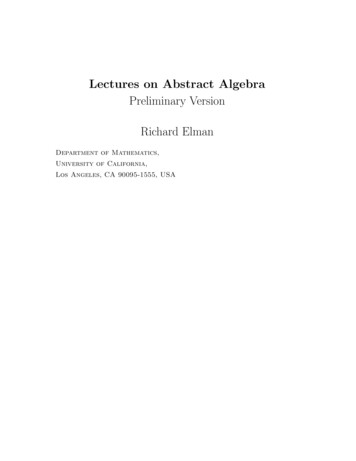
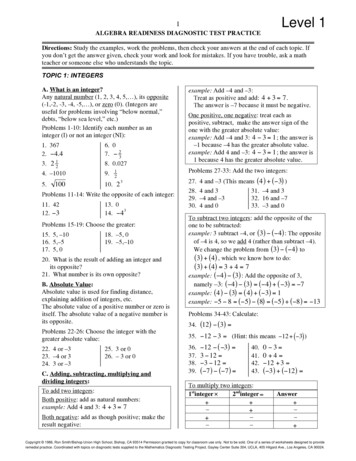

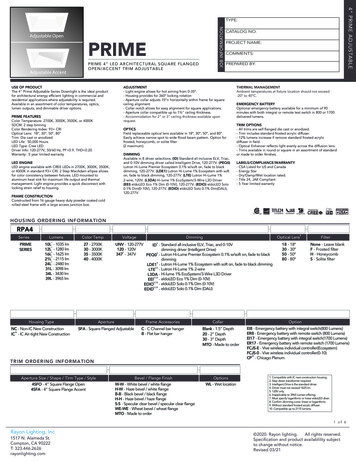
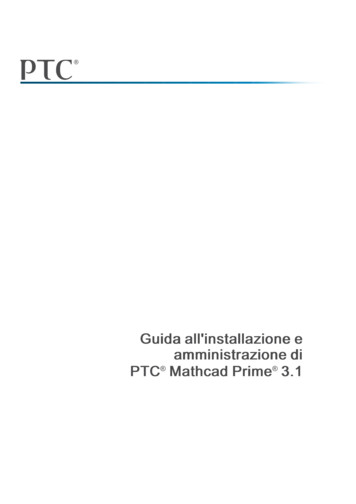



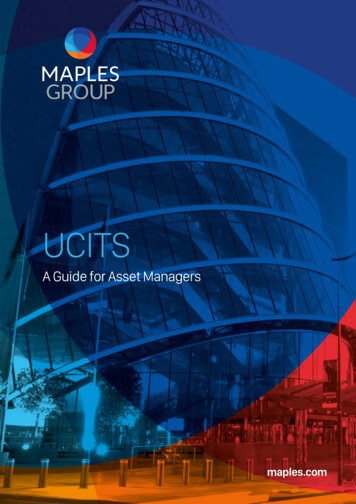
![Algorithms AppendixI:ProofbyInduction[Sp’16]](/img/13/98-induction.jpg)

